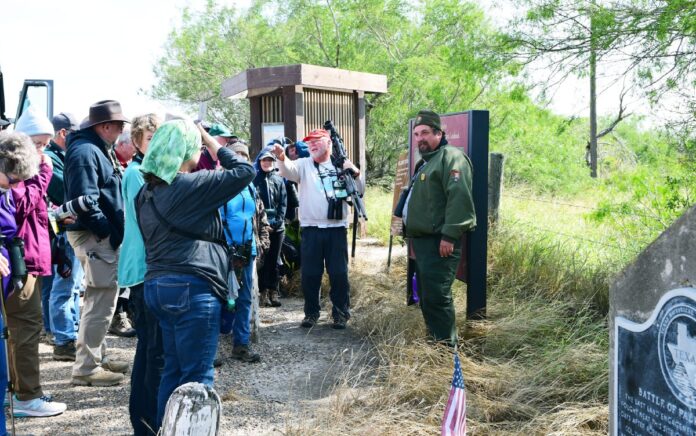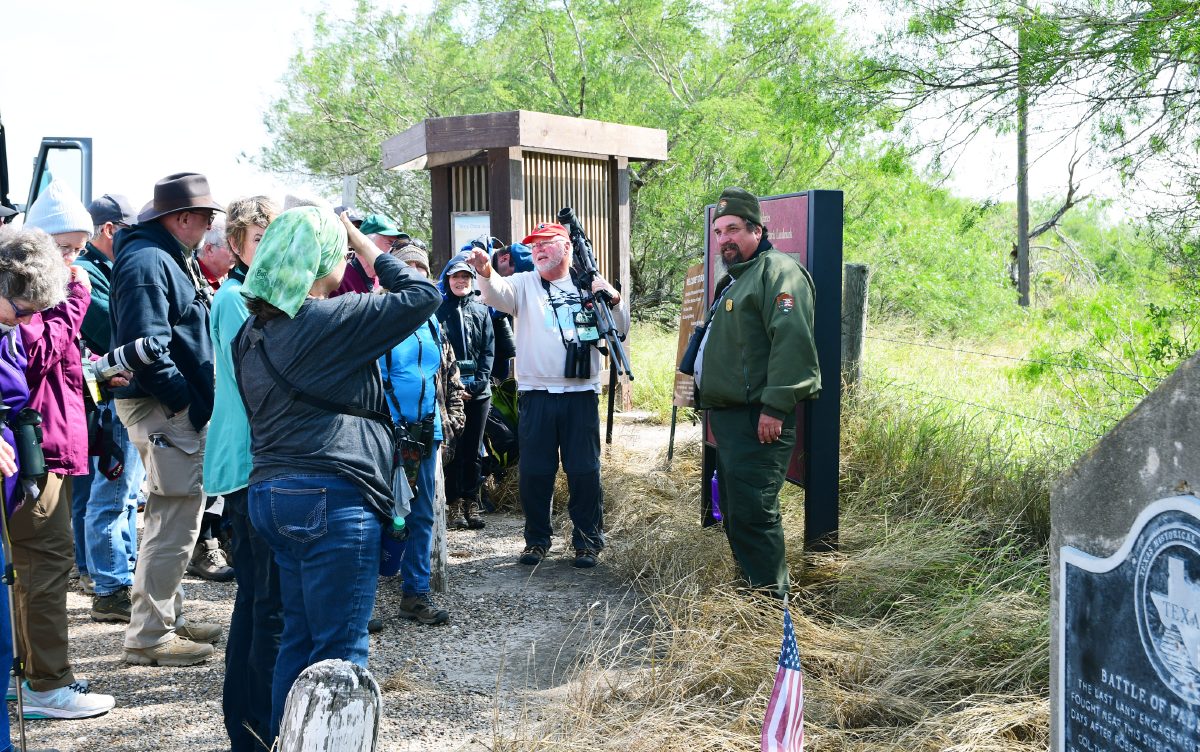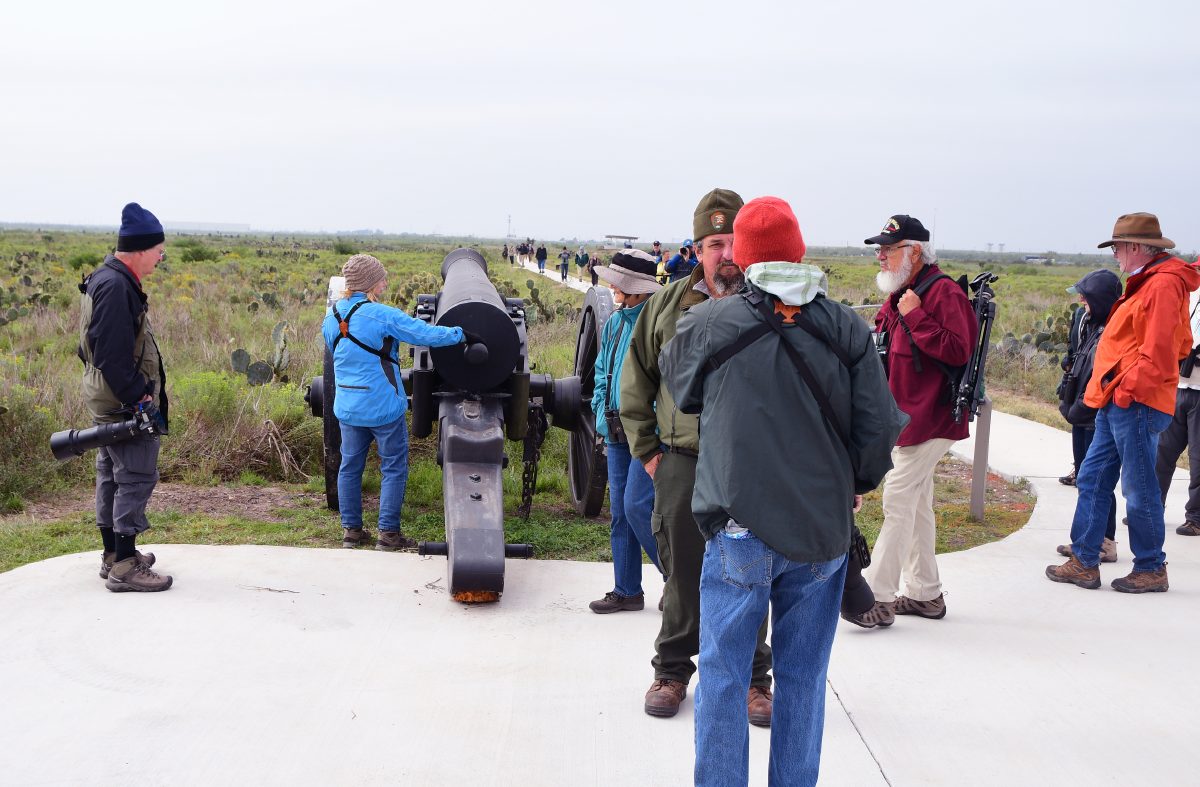BROWNSVILLE — The intersection of bird and battlefield isn’t one which readily springs to mind when discussing the subjects of avian field identification and military history.
But the Rio Grande Valley Birding Festival has raised the horizons on such possibilities by pairing Birds and Battlefields as one of its guided field trips.
“I love history and I’ve always felt you could combine the two,” said Joe Dunn, a birder who served as one of the guides on Saturday’s trip. “And often the battlefields, Gettysburg is one and Antietam, have excellent birding on the sites because they’ve preserved the habitat.”
This is the second year of the Birds and Battlefields trip, and its popularity has grown, as evidenced by a nearly full bus of 35 birders who participated this year.
Coming in cold
By 8 a.m. on the wide coastal plain at Palo Alto Battlefield National Historical Park, a red-brown nilgai cow watches intently before losing her nerve and breaking for cover a half-mile away, eating up yards in the antelope’s curious loping gallop before finding sanctuary in a stand of ebony trees.
The Battle of Resaca de la Palma occurred here during the U.S.-Mexico War on May 9, 1846, and ended with U.S. troops led by Gen. Zachary Taylor, later a U.S. president, driving the Mexican army of Gen. Mariano Aristo south across the Rio Grande.
The 54-degree temperature and a cutting north-northwest wind did have one benefit for the field trip participants by ensuring no respectable rattlesnake would be out and moving in such conditions.
As the wind rattled the lanyards on the flagpole and the Stars and Stripes stood straight out from its anchor, trip participants fanned out over the plain,
Harris’s hawk, check. Northern mockingbird, another check. White-tailed kite, check again.
As the day brightened to dull gray from dark, meadowlarks began to move and sing across the battlefield’s treeless plain.
Western meadowlarks are only found here in winter as they migrate, Dunn said. But they do overlap with their eastern counterpart during those months.
“That’s the song of the eastern meadowlark,” Dunn said, zeroing in on the distinctive trill at the end.
Battlefield No. 2
Back in the bus, the field trip redirects to the south, where the day’s second battlefield awaits.
The Battle of Palmito Ranch on May 13, 1865, was a different war. This was the final land battle of the Civil War, fought 34 days after Confederate Gen. Robert E. Lee surrendered the Army of Northern Virginia at Appomattox.
It is believed both Union and Confederate officers were fully aware of Lee’s surrender prior to the clash at Palmito Ranch.
“Some say over 100 were killed” on the Union side, said Rolando Garza, archaeologist and chief of resource management at Palo Alto Battlefield National Historical Park. He admits differences in accounts from Union and Confederate estimates are “extreme,” and he believes it is more likely each side had about 100 casualties, dead and wounded.
“It was a pretty fast-moving battle and we really don’t know the motive for Barrett (the Union commander at Brazos Island, Col. Theodore H. Barrett) coming onshore,” Garza said. “It could have just been a foraging run or he could have been trying to gain laurels, but we don’t know.”
The site of the Battle of Palmito Ranch right on the Rio Grande was a location which has seen more than one war.
“What the archeology tells us is it wasn’t much of a conflict,” Garza said of the Civil War battle. “But this battlefield became a National Historic Landmark in ‘97 because of the integrity of the setting, the character of the site, not because of the importance of the battle itself.
“There are not that many national historic landmarks, it’s a pretty high designation,” he added. “A lot of the territory appears like it did in the mid-19th Century (and) that whole area was occupied during the Mexican War when Taylor had 17,000 volunteers come through. And during the Civil War there was other activity all out there as well.”
Sparrows and armies
On Saturday, the activity is far more subdued, including that of the birds even as the sun breaks through and the day begins to warm.
A grasshopper sparrow, flitting coyly among the branches of a nearby mesquite, plays hide-and-seek with the birders. Then a white-tailed hawk finds itself the target of 25 pairs of binoculars and a half-dozen long lenses affixed to cameras.
The Battle of Palmito Ranch was a Confederate victory, a bookend to the war’s first battle at Fort Sumter, also won by the rebels. Palmito Ranch was decided when Confederate Col. John Salmon “Rip” Ford arrived with reinforcements and a half-dozen field artillery pieces.
“Boys, we have done finely,” Ford recalled in his memoirs, after Confederate troops had chased the Union soldiers back to their stronghold on Brazos Island. “We will let well enough alone, and retire.”
We offer the battlefield’s birds a similar respect, and board the bus for home.







